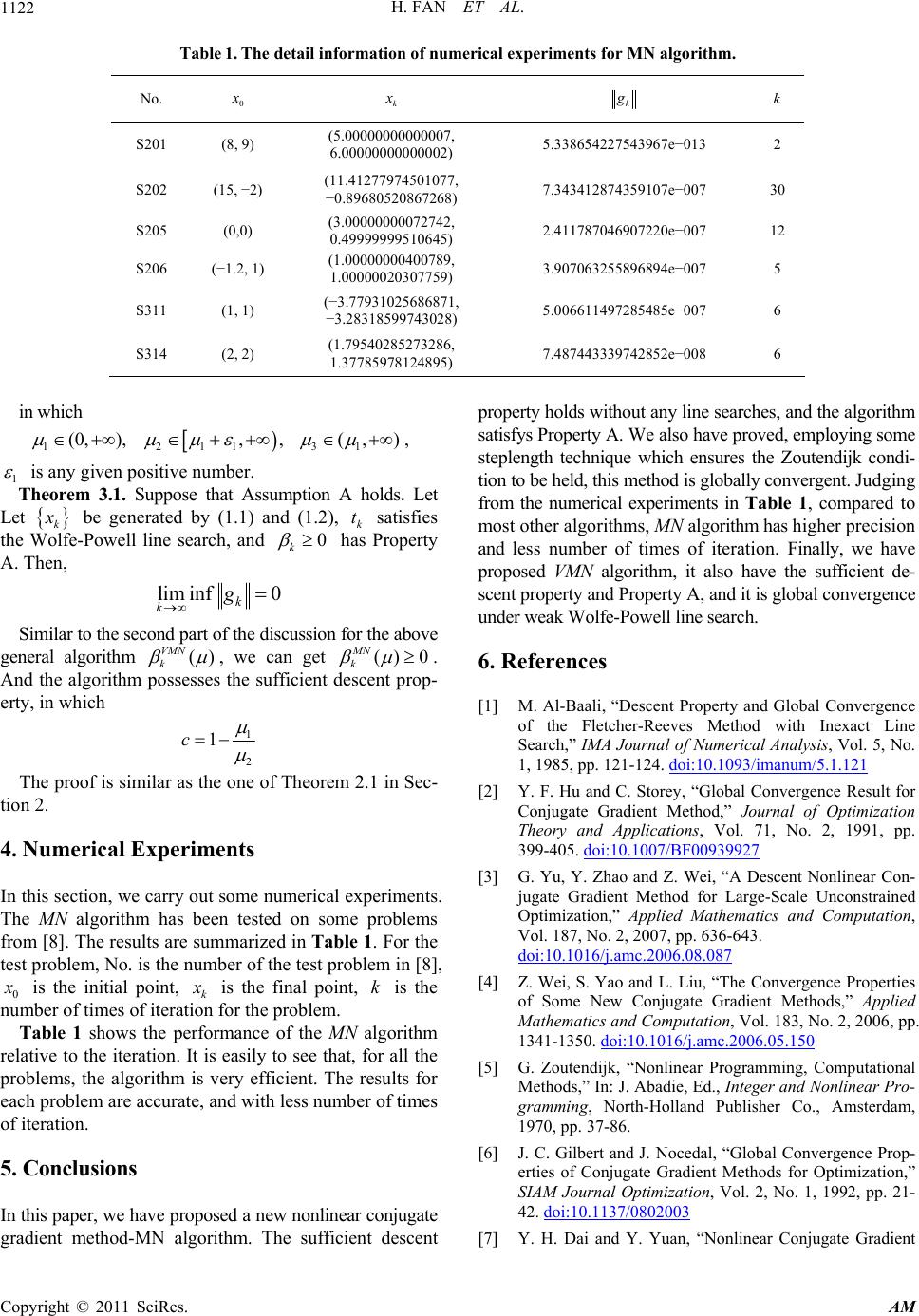
H. FAN ET AL.
Copyright © 2011 SciRes. AM
1122
Table 1. The detail information of numerical experiments for MN algorithm.
No. 0
k
k
k
S201 (8, 9) (5.00000000000007,
6.00000000000002) 5.338654227543967e−013 2
S202 (15, −2) (11.41277974501077,
−0.89680520867268) 7.343412874359107e−007 30
S205 (0,0) (3.00000000072742,
0.49999999510645) 2.411787046907220e−007 12
S206 (−1.2, 1) (1.00000000400789,
1.00000020307759) 3.907063255896894e−007 5
S311 (1, 1) (−3.77931025686871,
−3.28318599743028) 5.006611497285485e−007 6
S314 (2, 2) (1.79540285273286,
1.37785978124895) 7.487443339742852e−008 6
in which
1(0, ),
211
,,
31
(, )
,
1
is any given positive number.
Theorem 3.1. Suppose that Assumption A holds. Let
Let
k
be generated by (1.1) and (1.2), k satisfies
the Wolfe-Powell line search, and
t
0
k
has Property
A. Then,
lim inf0
k
kg
Similar to the second part of the discussion for the above
general algorithm ()
VMN
k
, we can get .
And the algorithm possesses the sufficient descent prop-
erty, in which
() 0
MN
k
1
2
1c
The proof is similar as the one of Theorem 2.1 in Sec-
tion 2.
4. Numerical Experiments
In this section, we carry out some numerical experiments.
The MN algorithm has been tested on some problems
from [8]. The results are summarized in Table 1. For the
test problem, No. is the number of the test problem in [8],
0
is the initial point, k
is the final point, is the
number of times of iteration for the problem.
k
Table 1 shows the performance of the MN algorithm
relative to the iteration. It is easily to see that, for all the
problems, the algorithm is very efficient. The results for
each problem are accurate, and with less number of times
of iteration.
5. Conclusions
In this paper, we have proposed a new nonlinear conjugate
gradient method-MN algorithm. The sufficient descent
property holds without any line searches, and the algorithm
satisfys Property A. We also have proved, employing some
steplength technique which ensures the Zoutendijk condi-
tion to be held, this method is globally convergent. Judging
from the numerical experiments in Table 1, compared to
most other algorithms, MN algorithm has higher precision
and less number of times of iteration. Finally, we have
proposed VMN algorithm, it also have the sufficient de-
scent property and Property A, and it is global convergence
under weak Wolfe-Powell line search.
6. References
[1] M. Al-Baali, “Descent Property and Global Convergence
of the Fletcher-Reeves Method with Inexact Line
Search,” IMA Journal of Numerical Analysis, Vol. 5, No.
1, 1985, pp. 121-124. doi:10.1093/imanum/5.1.121
[2] Y. F. Hu and C. Storey, “Global Convergence Result for
Conjugate Gradient Method,” Journal of Optimization
Theory and Applications, Vol. 71, No. 2, 1991, pp.
399-405. doi:10.1007/BF00939927
[3] G. Yu, Y. Zhao and Z. Wei, “A Descent Nonlinear Con-
jugate Gradient Method for Large-Scale Unconstrained
Optimization,” Applied Mathematics and Computation,
Vol. 187, No. 2, 2007, pp. 636-643.
doi:10.1016/j.amc.2006.08.087
[4] Z. Wei, S. Yao and L. Liu, “The Convergence Properties
of Some New Conjugate Gradient Methods,” Applied
Mathematics and Computation, Vol. 183, No. 2, 2006, pp.
1341-1350. doi:10.1016/j.amc.2006.05.150
[5] G. Zoutendijk, “Nonlinear Programming, Computational
Methods,” In: J. Abadie, Ed., Integer and Nonlinear Pro-
gramming, North-Holland Publisher Co., Amsterdam,
1970, pp. 37-86.
[6] J. C. Gilbert and J. Nocedal, “Global Convergence Prop-
erties of Conjugate Gradient Methods for Optimization,”
SIAM Journal Optimization, Vol. 2, No. 1, 1992, pp. 21-
42. doi:10.1137/0802003
[7] Y. H. Dai and Y. Yuan, “Nonlinear Conjugate Gradient